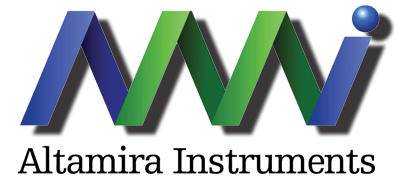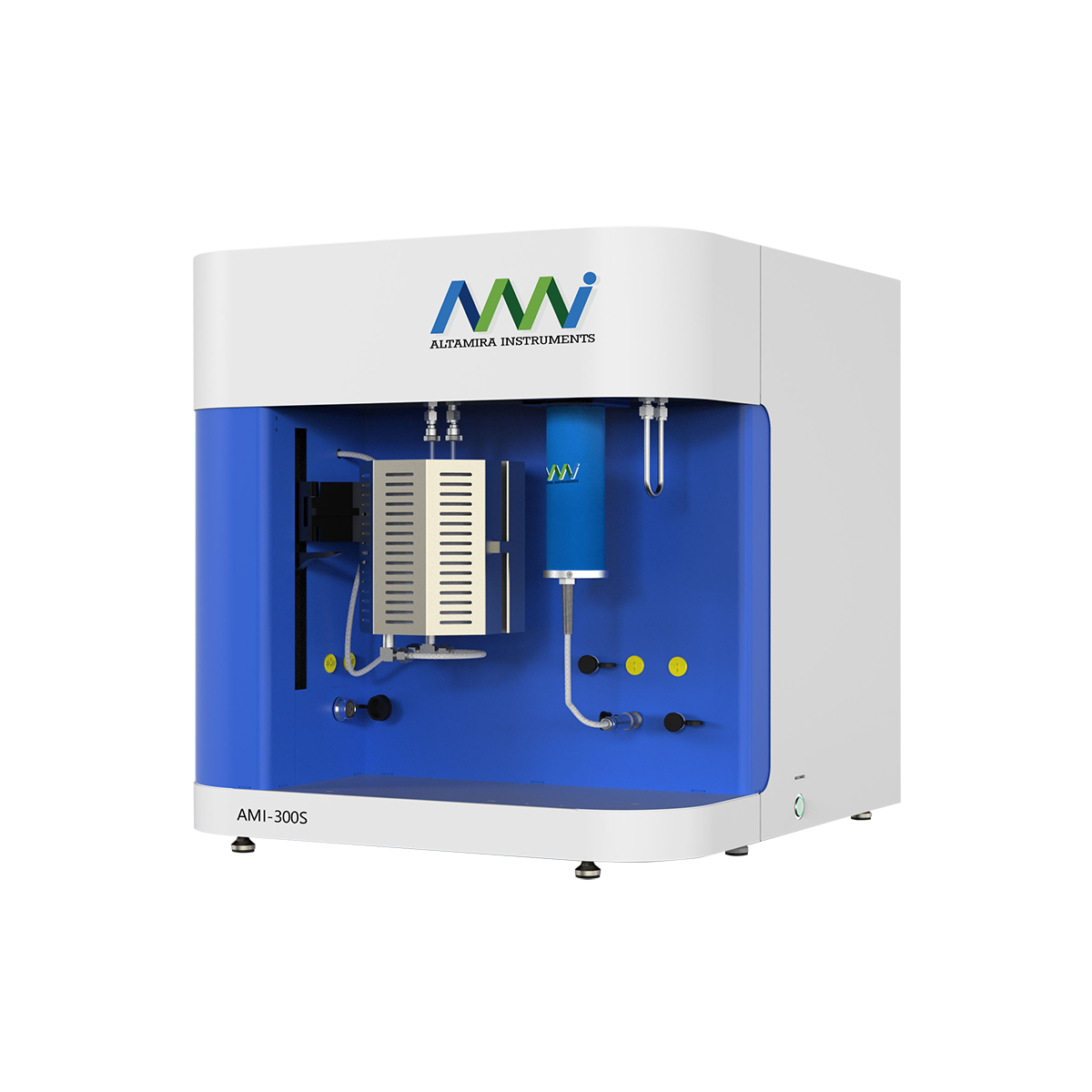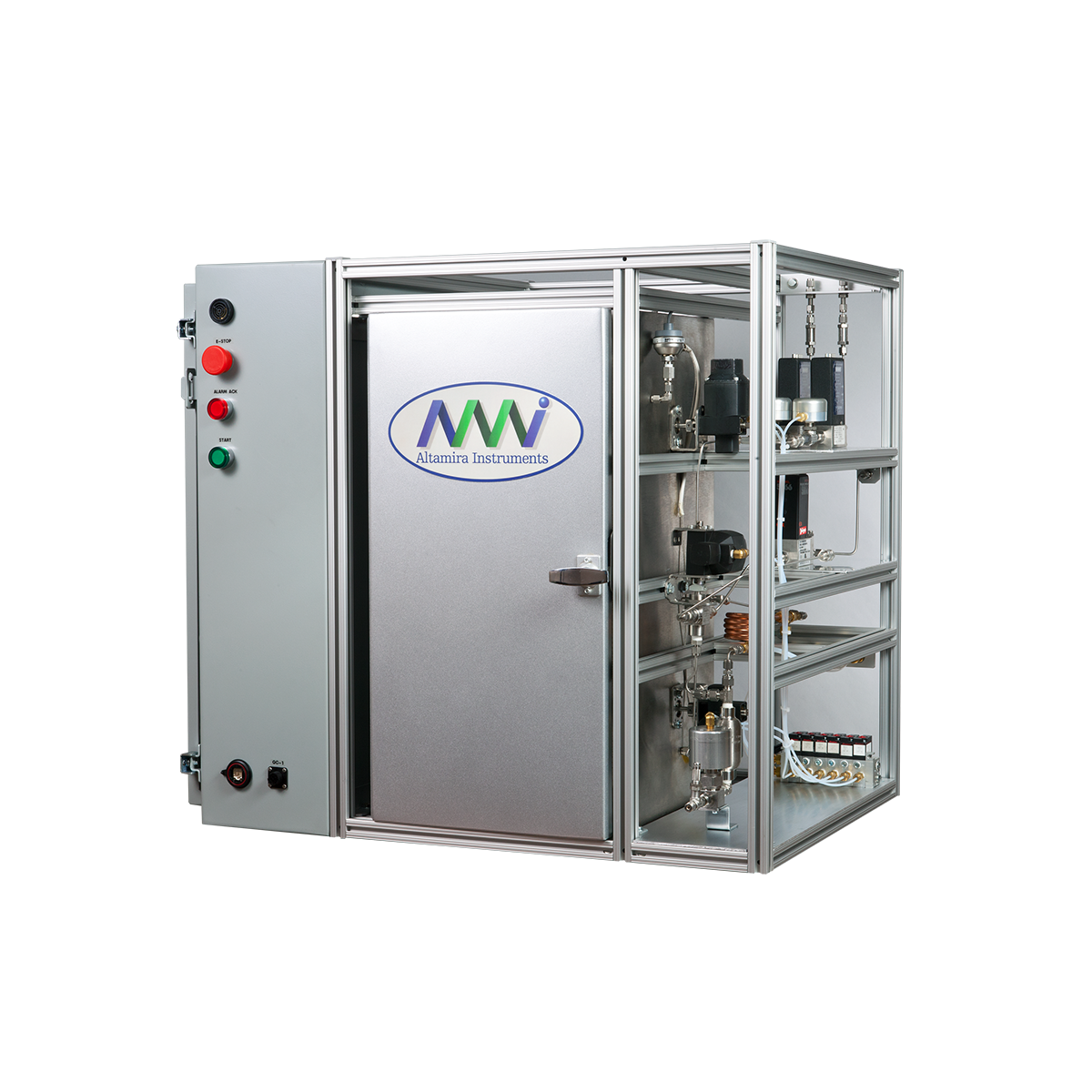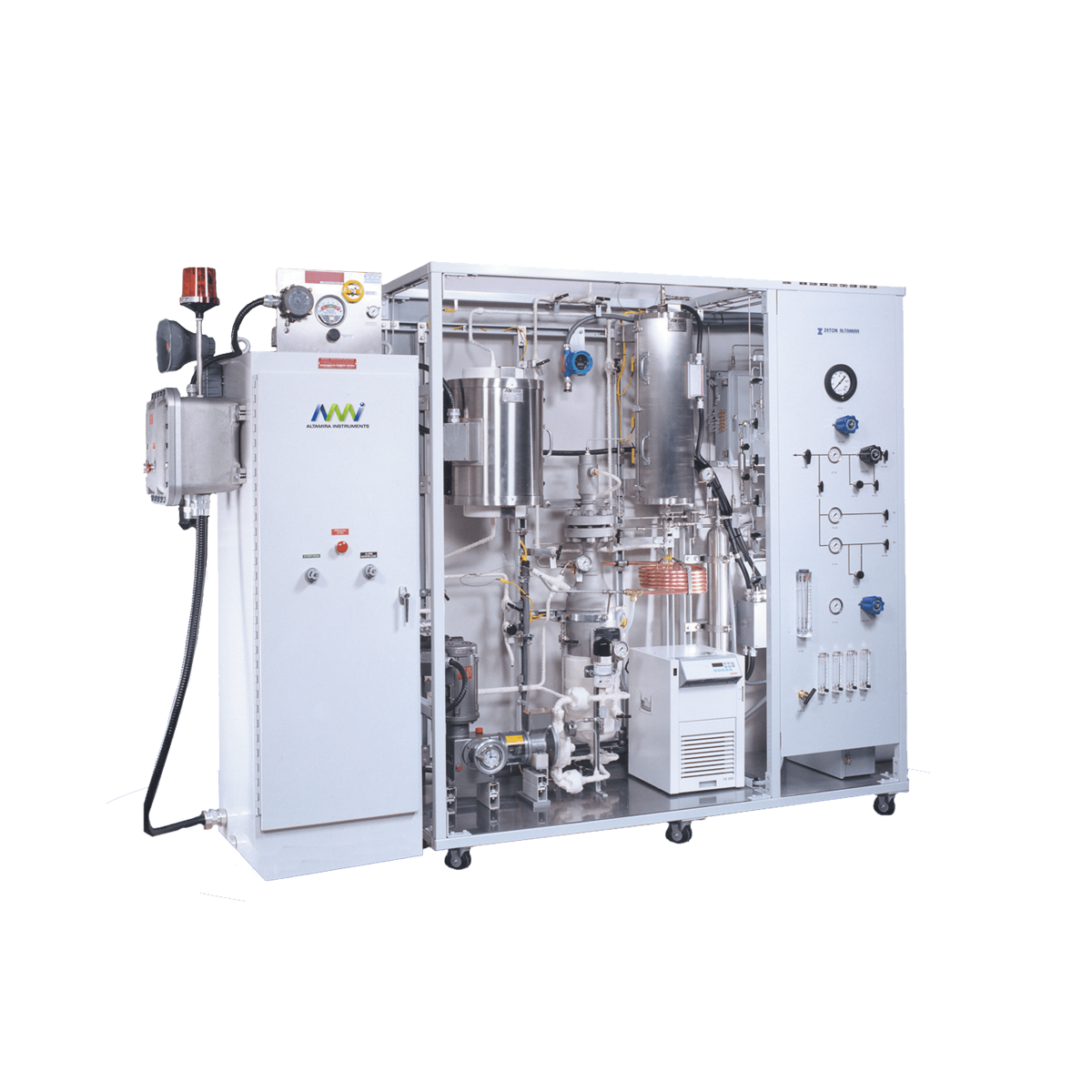Perform dynamic temperature-programmed catalyst characterization experiments unattended with the latest generation fully automated chemisorption analyzer from Altamira Instruments. Determine metal dispersion, relative activity, adsorption strength, in one third the time of traditional volumetric methods. Analyze the off gas with the standard TCD or integrate a mass spectrometer or other detectors (FID, GC, FTIR) as options. Customize the instrument for use as an atmospheric reactor, carry out lengthy pre-treatments, and provide fast-switched feed compositions. SSITKA capability and more features are also available. The leader in automated TPD/TPR/O/TPRx, and pulse chemisorption instruments since 1985, Altamira Instruments is the catalyst researcher’s primary resource for automated catalyst test instruments and bench-scale reactor systems.
AMI-300
AMI-300 Chemisorption Analyzer

Dynamic Chemisorption
The AMI-300 is the latest generation automated chemisorption analyzer offered by Altamira Instruments. Developed by and for catalyst researchers, it and its predecessors, the AMI-1, AMI-100, and the AMI-200, were first in the industry to offer a fully automated system capable of performing all the major dynamic techniques required for fully characterizing a catalyst. The AMI-300 utilizes our proven technology for performing the following dynamic procedures:
- Temperature programmed desorption (TPD)
- Temperature programmed reduction/oxidation (TPR/O)
- Temperature programmed reaction (TPRx)
- Gas-phase isotherm reaction experiments (standard interal gas-mixing)
- Pulse chemisorption
- Catalyst treatment
- Flow BET surface area
- Pulse calibration
Up to 99 procedures can be linked together consecutively to provide a complete characterization experiment.
All experimental procedures can be designed and stored for easy retrieval.
Hardware and Operation
The AMI-300 is a fully automated catalyst characterization instrument wherein the LabVIEW-based software is used to switch gas streams, control gas flow rates, blend gases, control temperatures, control ramp rates, and to collect all the data needed to quantify the adsorption and desorption of gas molecules on the surface of a catalyst.
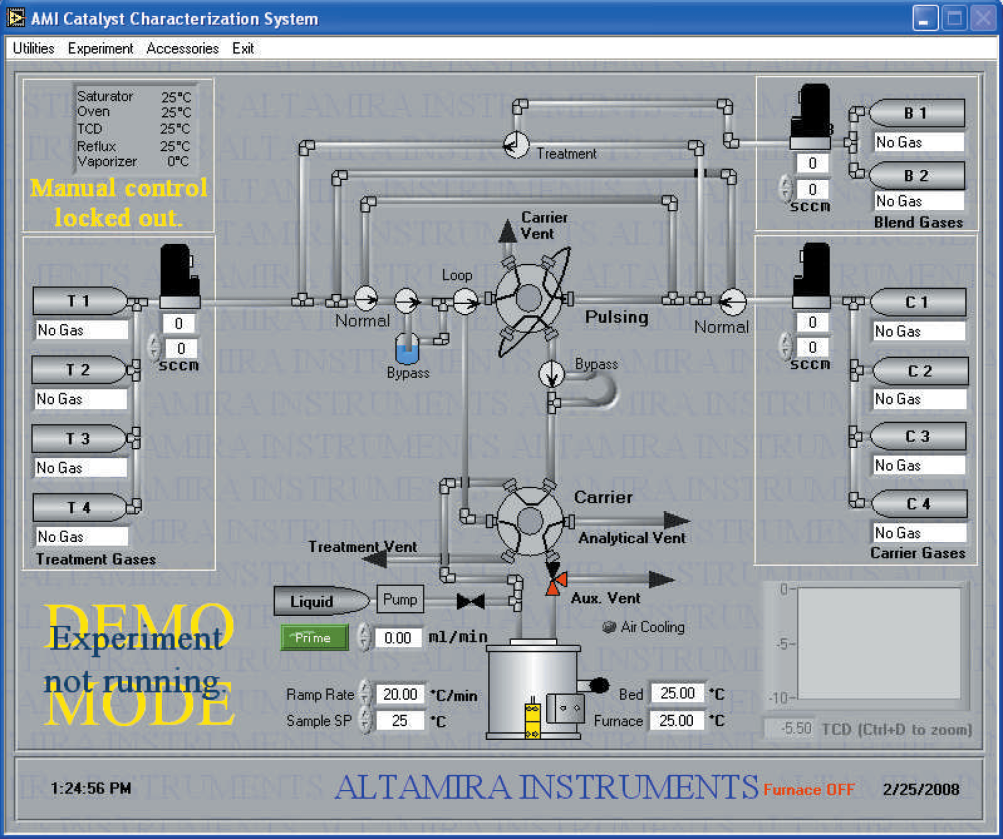
Functions
- High-precision electronic mass flow controllers, which ensure a stable baseline with changing temperatures and also ensure quality of data
- Use of 1/16" stainless steel tubing to minimize dead volume
- A clamshell furnace with adjustable mounting to ease insertion and removal of samples
- Capability of heating catalyst samples to 1200ºC with linear temperature ramps from 1ºC to 50ºC per minute. (Higher and lower ramp rates are also available).
- A subambient option which provides the capability to operate linearly, between -130ºC and 1200ºC
- Automatic air-cooling of the furnace which is provided to speed the time between experiments
- A Universal Temperature Zone which controls the temperature of all valves and lines downstream of the reactor. The temperature of this zone is controlled by the software and serves to prevent both condensation and retention of the adsorbate in valves and lines upstream of the detector.
- A saturator is provided as an option to suffuse the treatment gas with liquid vapors. The temperature of the saturator is controlled by the software. In applications where condensation of liquid vapors in the line between the saturator and the Universal Temperature Zone is a concern, a reflux heater is available to ensure that no condensation takes place.
- A highly linear Thermal Conductivity Detector (TCD) is standard. The resolution of the TCD is operator defined, and is controlled by the software.
- A choice of TCD filaments is offered to maximize sensitivity and chemical compatibility of the instrument
Computer Control and Data Acquisition
The AMI-300 is fully automated and computer-controlled for ease of operation and reliability. It is designed so that experiments can be run on an unattended basis. This PC, supplied with a Windows based operating system, can be networked and is capable of managing other laboratory tasks in addition to operation of the instrument. The control and data acquisition functions are performed by LabVIEW applications software. Using this software, a complete experiment can be set-up in minutes, and it can be saved for future use or modification. The control portion of the software controls and regulates all valve positions, temperatures, flow rates, and detector parameters. The software also allows for the use of an alarm matrix. Data acquisition occurs at a selected rate for optimum performance. An “Overview” screen shows the status of the unit at a glance, providing information on the position of all valves, type of gas connected to each port, temperatures, and detector signal. Lines change color to illustrate the current flow path. In manual mode any valve can be switched just by a click of the mouse on its icon. Gas flow and temperature setpoints can be entered from this screen.The most sophisticated data handling package in the industry is included which allows the user to display and integrate signal peaks, calculate chemisorptive parameters, peak fit, and overlay data.
Detectors
The AMI-300 comes standard with a highly linear TCD. In addition to the TCD, AMI instruments have been delivered with a wide range of auxiliary detection devices.
Choices of auxiliary detectors have included:
| Mass Spectrometer | GC with FID/TCD/FPD |
| Flame Ionization Detector | FTIR |
Any detector that provides an analog output or which can communicate through DDE, Serial ports, OPC, ActiveX, or other Windows protocols can be triggered by the AMI-300. The degree to which the auxiliary detection device is to be integrated with the instrument can be specified and incorporated into the control software.
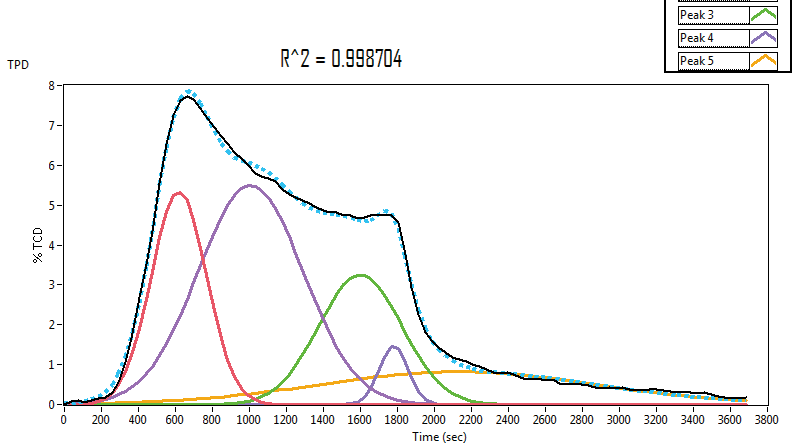
Gas Blending
The AMI-300 comes standard with gas blending capabilities that avoid any need to purchase expensive gas blends to conduct experiments such as TPR or TPO. The AMI-300 includes an auxiliary gas line by means of which a gas can be mixed with the carrier gas to provide custom-blended gases. An in-line static gas mixer assures homogeneity of the resulting blend.
The gas blending capability also facilitates the use of the AMI-300 as a gas-phase, atmospheric reactor.
Customization
Altamira Instruments was founded by catalyst researchers. We understand your requirements. Our experts are available to answer your questions and help in your applications. Our strength lies in being able to customize a system to meet your exact needs. Examples of some of Altamira’s instrument customizations include:
| Additional gas feed(s) | Auxiliary pretreatment station |
| Corrosive service package | Fast switching gas feeds |
| High pressure characterization | Integrated pretreatment station |
| Methanizer, incorporated with FID | Multiple detection devices |
| Multiple Workstations | Oxygen Storage Capacity (OSC) |
| Sulfur-tolerant instruments | Vaporized liquid feed(s) |
Specifications
| Standard Catalyst Charge: 0.1 – 1.0 grams (can be increased with custom sample tubes) | Temperature Range:-130ºC to +1200ºC with Subambient Option |
| 50ºC/minute standard | Operating Pressure: Atmospheric |
| Gas Inlets: 4 carrier, 4 treatment, 2 blend (Others Available) | Gas Flow Rates: 5 to 50 sccm (Others Available) |
| Reactor Types: Quartz U-tubes, Bubble Tubes, Monolith Tubes (up to 1" diameter) | Primary Detectors: 4 filament TCD with choice of material (W, Au/W) |
| Materials of Construction: Flow path: 316 stainless steel | Seals: Viton, Buna-N, or Premium Seals (depending on customer chemical compatibility requirements) |
| Dimensions: 64 cm (W), 64 cm (H), 64 cm (D) | Weight: approximately 55 kg (120 lbs) |
| Power Requirements: 110-120 or 220-240 Volts, single phase, 50 or 60 Hz. ~20 amp service |
Features
Seven (7) Standard Procedures - Pulse chemisorption, TPR/TPO, TPD, TPRx, treatment, pulse calibration, and flow BET. Ability to link 99 procedures into one experiment.
Three Independent Gas Sources - In addition to a carrier gas and a treatment gas, the AMI-300 provides one additional independently controlled auxiliary gas inlet which can be blended with the carrier gas or treatment gas.
Ten (10) Gas Ports - Gas ports located on the back of the instrument minimizes the time expended changing gases. Four ports each for treatment and carrier gases. Two ports are available for gas blending or auxiliary gases. Additional ports can be added.
Electronic Flow Controllers - Unit uses high quality linear mass flow controllers to display and control gas flows. Flow rate span is 0-50 Sccm (standard). Other ranges are available upon request.
Interchangeable Valve Loops - Provide an easy way to reach the appropriate level of sensitivity for different samples.
Liquid Vaporizer - Unit can be equipped with a heated sparger-type saturator for easy introduction of volatile liquids.
High Temperature Furnace - Temperature up to 1200ºC; with sub-ambient cooling, the lower limit is -130ºC. Furnace can be linearly ramped from 1ºC/min to 50ºC/min.
Air Cooling - Cools the furnace rapidly for quick sample turn around.
Sample Temperature - Measured by a moveable thermocouple placed at the top of the sample bed.
Various Sample Holders - Unit accommodates a variety of quartz U-tubes sized to accommodate various catalyst volumes and sizes: straight, bubble, preheat, monolith. Samples may be powders, pellets, extrudates or honeycomb cores.
Easy Sample Loading - A movable furnace allows easy removing and loading of the sample holder.
Trap - A trap that may be filled with a desiccant or used as a cold trap is provided downstream of the sample holder in order to remove condensables before the TCD.
Heated Null Station - Ensures accurate calibration pulses without contact with the sample.
Injection Port - A syringe injection port is provided for exact loop volume calibration.
Heated Lines - All lines, valves, and parts of the liquid vaporizer are heated to prevent condensation.
Thermal Conductivity Detector - Highly reliable 4-filament TCD used to quantify gas uptakes. Excellent linearity, accuracy, sensitivity, and stability. Several filament options are available.
Direct Mass Spectrometer Link - MS data can be integrated in real-time with AMI-300 data using Direct Data Exchange (DDE).
Auxiliary Detectors - Can accept any auxiliary detector providing a voltage analog output, such as a flame ionization detector (FID).
Low Internal Volume - Low volume valves and 1/16” lines are used to reduce void volume and minimize peak spreading.
Materials of Construction - Seals and materials are custom engineered to meet your specifications.
Safety Features - Among others: independent over-temperature protectors for furnace, resealable pressure relief valves, check valves, circuit breakers, and fuses. System is designed to fail in safe mode.
Fliter - ensure to eliminate carryover of light particles of sample into the instrument manifold with the provision of filters and the operator is able to clean or replace the filters.
